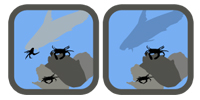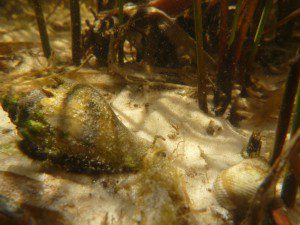In the Grass, On the Reef: Testing the Ecology of Fear
Premieres on WFSU-TV Wednesday, June 29 at 7:30 PM, 6:30 CT. In high definition where available.
Rob Diaz de Villegas WFSU-TV
 This clip is a short segment on one of the predators featured in this program: the horse conch. It’s practically an ecosystem onto itself, as you can see in the video’s poster frame above. Barnacles, crepidula, bryozoans, and other marine creatures that affix themselves to hard surfaces settle on its shell. In the video you’ll see its bright orange body as it roams the seagrass beds of the Forgotten Coast. And you’ll see it eat another large predatory snail, the lightning whelk.
This clip is a short segment on one of the predators featured in this program: the horse conch. It’s practically an ecosystem onto itself, as you can see in the video’s poster frame above. Barnacles, crepidula, bryozoans, and other marine creatures that affix themselves to hard surfaces settle on its shell. In the video you’ll see its bright orange body as it roams the seagrass beds of the Forgotten Coast. And you’ll see it eat another large predatory snail, the lightning whelk.
The coast is a rough place. At least it is for mollusks and crustaceans.
 Just think about it. When people are in their homes on Cape San Blas, St. George Island, or Alligator Point- enjoying the sun, sand, and water- they are surrounded by violence. And we benefit from this violence! Stone crabs gobble down mud crabs, those mud crabs don’t eat oysters, and we have more oysters to clean the water and to eat ourselves (after they reach maturity). Crown conchs eat periwinkle snails (pictured to the right), and the cordgrass making up coastal salt marshes flourishes and continues providing habitat for commercially important fish and preventing erosion. And for every snail or crab eaten, many more might be scared and alter their behavior.
Just think about it. When people are in their homes on Cape San Blas, St. George Island, or Alligator Point- enjoying the sun, sand, and water- they are surrounded by violence. And we benefit from this violence! Stone crabs gobble down mud crabs, those mud crabs don’t eat oysters, and we have more oysters to clean the water and to eat ourselves (after they reach maturity). Crown conchs eat periwinkle snails (pictured to the right), and the cordgrass making up coastal salt marshes flourishes and continues providing habitat for commercially important fish and preventing erosion. And for every snail or crab eaten, many more might be scared and alter their behavior.
It’s strange to think that these little critters have such an impact on us (Read a post by Dr. Randall Hughes on the financial value of coastal ecosystems). They affect the food we eat, the economy of the coast. They affect the physical coast itself, as the marshes and oyster reefs build the edge of the coast by holding sediment. This is why David Kimbro and Randall Hughes are out their studying it, and why we decided to make a program about it. And also, honestly, those critters look pretty cool!
